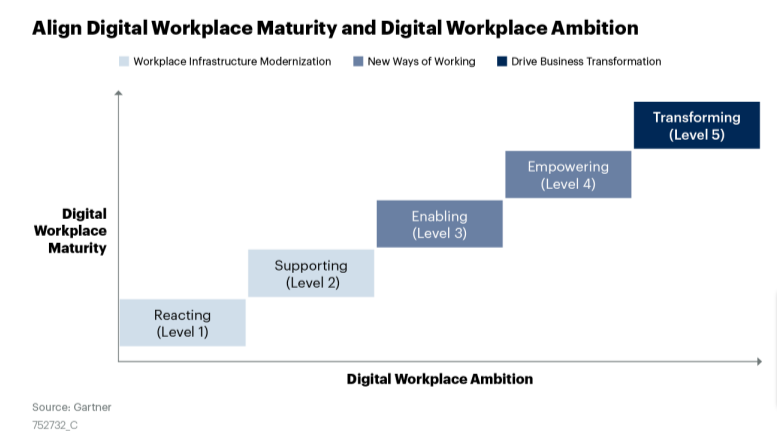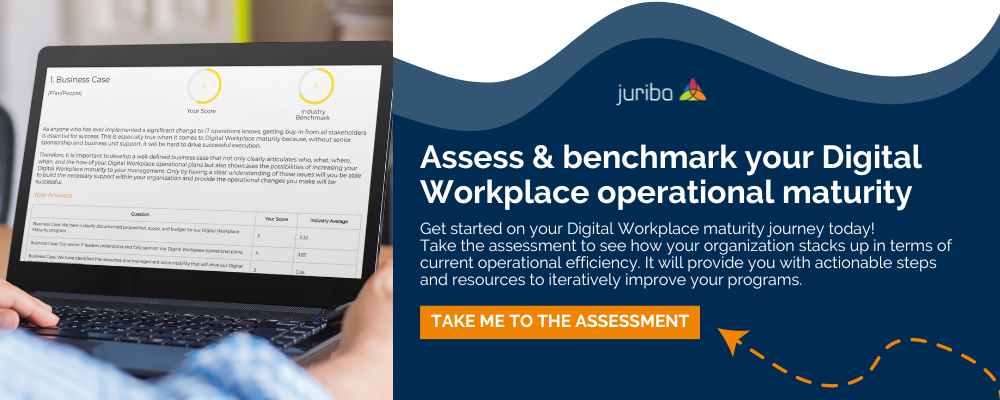The key to long-term digital workplace success: executive management support
October 19th, 2023
5 min read
By Barry Angell

In a 2023 Gartner Survey, 27 % of CIOs and other technology executives identified "ensuring that business leaders understand the possibilities" as their #1 struggle while developing a vision for digital change. The third spot was shared between "communicating the vision to leaders and team managers across the enterprise" and "getting input from stakeholders outside IT." Clearly, there is a disconnect that needs to be addressed.
In this article, I will provide you with insights and lessons learned from my experience spanning over 20 years. My hope is that these insights will not only help you bridge the gap and overcome the disconnect between your management and your digital workplace strategy but also ignite a fire within them, driving their enthusiasm and commitment.
The struggle is real...
As a digital workplace leader, you often sit not between two but three chairs: IT, business, and management. Your role is somewhat lonely as you don't fit into any of the boxes: You are tech-savvy with tons of technical know-how acquired over time, but you also understand how technology needs to support the business.
Although you create and nurture relationships across the business and IT, no one has empathy for how employees experience technology in the workplace quite the way you do. Consequently, it is hard to prioritize digital workplace investments and initiatives, especially as business goals keep changing and new digital workplace technologies, management tools, and strategies constantly flooding the market. In addition, it is incredibly hard to pinpoint the right timing for investing, considering each organization's unique IT landscape and requirements.
... and the stakes couldn't be higher!
Failing to adequately mature your digital workplace results in less budget and resources being dedicated, leading to worse employee technology experiences and loss of productivity. The struggle to prioritize becomes even more pressing as employees become increasingly dependent on technology for their work.
The digital workplace has evolved into an essential component of modern business operations, with employees relying on it to collaborate, communicate, and access critical information. This growing dependence on technology further intensifies the need for I&O leaders to make informed decisions about where to invest their resources. However, with multiple options available, it becomes challenging to determine which investments will truly drive the desired outcomes and align with business objectives. I&O leaders must carefully evaluate the potential impact and value of each digital workplace investment in the context of their organization's specific goals and priorities.
Ultimately, it is crucial to manage the expectations of executives and IT leaders. Often, there is a gap between what can be realistically achieved within the allocated investment and the ambitious vision they have for the digital workplace. This misalignment can lead to frustration and a lack of support for digital transformation initiatives. By setting realistic expectations and fostering a collaborative approach, they can create a shared understanding of the digital workplace's potential and the steps needed to realize it.

Know where you are and where you are going
To solve this conundrum, you will need to assess your current state (what capabilities do you have at the moment?) and plan out your future state (what capabilities will you need in the future?) to truly understand where your gaps are and therefore what areas you will need to invest in. Once you have your baseline, you need to evaluate your existing initiatives, methodologies, strategies, and technologies are appropriate for your digital workplace maturity level. This ensures that the chosen solutions and technologies are a good fit for the organization's current needs and capabilities.
However, the end goal is to maximize your long-term success. This only happens if you align your digital workplace maturity with the organization's digital workplace ambitions. For example, many executive stakeholders are looking to drive true business transformation. For this to happen, IT and business units must, for example, share responsibility of technology creation, work tasks need to be digitalized, and digital friction has to be eliminated. This won't happen if your IT department is worried about deploying security patches and keeping devices within their lifecycle. It requires a very high level of digital workplace maturity.
Through 2027, IT leaders who align digital workplace investments with current and desired levels of maturity and overall digital ambitions will reduce the waste associated with untimely and unsuitable activities by 50%.
- Gartner (2023)
Use storytelling and Gartner's digital workplace ambitions to paint the picture
Rather than bombarding your executives with technical specs and technology jargon to get buy-in, use the power of storytelling. Storytelling allows you to paint a vivid picture that aligns with their business priorities, igniting their enthusiasm and commitment.
When executives are presented with a compelling narrative that showcases the possibilities and benefits of digital transformation, they are more likely to understand and support the vision. By telling stories that illustrate how the digital workplace can enhance collaboration, communication, and access to critical information, you can effectively demonstrate the value and impact of digital investments.
This approach helps executives see beyond the technical details and instead visualize how the digital workplace can drive business transformation and improve employee experiences. Through storytelling, you can bridge the gap, capture their attention, and inspire them to prioritize and invest in the digital workplace.

What is the story you should be telling? While your story will be slightly different from anyone else's, we have found Gartner's progression of digital workplace ambition extremely helpful.
- At the very beginning of an organization's digital workplace maturity journey is the Workplace Infrastructure Modernization. This step serves as the foundation of the digital workplace. IT efforts are primarily directed toward efficiently managing service requests, incidents, changes, operating system and application updates, and the ever-expanding array of devices.
- The next ambition level, New Ways of Working, centers around streamlining IT resources, management tools, and processes. It marks a shift from solely being technology managers to becoming catalysts for business productivity and employee engagement through the strategic use of technology. This also encompasses enhancing the digital employee experience (DEX) and fostering workforce digital dexterity through employee enablement programs and effective organizational change management practices.
- The highest level of ambition, Drive Business Transformation, requires a complete transformation in how IT and business units collaborate and leverage technology for business advantage. It requires shared responsibility between IT and business units in the creation of technology solutions that digitize work tasks and remove digital friction. Additionally, this ambition extends to promoting team and personal growth, prioritizing employee wellness, and fostering broad employee engagement throughout the organization.
Reframing the discussion to invest to save: A new approach to digital workplace transformation
There is one mistake most digital workplace leaders make when trying to get executives fired up about this: They are trying to sell it as something new. A new methodology. A new IT management strategy. And in a way, it is. But here is the thing: reframe the discussion. You will continue to do what you do anyway: managing applications, users, devices, etc. Digital workplace management is just giving you a way to do the same things more strategically and efficiently. It gives you a direction and a methodology in all the messiness.
Efficiency is crucial in any organization; most are nowhere near as efficient as possible. The digital workplace allows one to streamline processes, automate tasks, and improve productivity. The above mentioned ambitions give you a North Star to work towards.
In the past twenty-plus years, I have found that the best approach is to simply reframe the discussion into "we need to invest a little to save big." By investing in the right technologies and strategies, organizations can eliminate manual and redundant processes, reduce operational costs, and free up valuable resources.
This shift in focus from a cost-centric approach to an efficiency-centric approach allows organizations to position their digital workplace initiatives as a means of achieving long-term savings and operational excellence through efficiency and standardized processes. It lets you garner the support and commitment needed to successfully navigate their digital transformation journey and reap the rewards of a fully optimized and future-ready digital workplace.
By reframing the discussion around digital workplace transformation to focus on investing to save, organizations can overcome the challenges of securing a budget and gaining buy-in.
What's next?
Juriba has recently published an interactive and comprehensive assessment tool called the Digital Workplace Operational Assessment. It is specifically designed to help you uncover your organization's strengths and weaknesses, as well as any potential gaps or obstacles that may hinder you in achieving your digital workplace goals.
It provides a detailed analysis across 12 critical dimensions that impact your ability to plan, build, deploy, and operate workplace services. With personalized advice and resources tailored to your organization's digital workplace journey, this assessment offers a clear snapshot of your current standing and helps you navigate toward success. It takes about 15-20 minutes.
Barry is a co-founder of Juriba, where he works as CEO to drive the company strategy. He is an experienced End User Services executive that has helped manage thousands of users, computers, applications and mailboxes to their next IT platform. He has saved millions of dollars for internal departments and customers alike through product, project, process and service delivery efficiency.





















